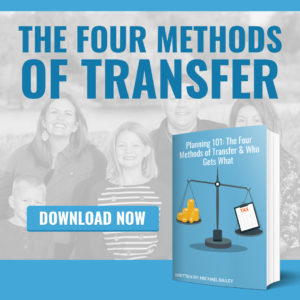 I get asked about how long it will take to get a trust funded all the time. However, not everyone I talk to even knows what it means to fund a trust. Funding a trust in the process of re-titling assets in the name of the trust, or pointing assets to be Forms put into the trust at the time of death, so that the assets are owned by the trust. A trust can only control what happens to assets that are owned by the trust, so funding the trust, or getting assets into the trust, is a critical step in setting up a trust.
I get asked about how long it will take to get a trust funded all the time. However, not everyone I talk to even knows what it means to fund a trust. Funding a trust in the process of re-titling assets in the name of the trust, or pointing assets to be Forms put into the trust at the time of death, so that the assets are owned by the trust. A trust can only control what happens to assets that are owned by the trust, so funding the trust, or getting assets into the trust, is a critical step in setting up a trust.
Funding a trust is a separate action and separate legal matter from preparing, drafting, and signing a trust. I give my client options when it comes to funding the trust. A client can fund the trust by themselves, or they can hire me to fund the trust. I do teach my clients how to fund a trust, so most clients are able to take that process on by themselves, as I can get expensive when it comes to funding a trust. I charge the price I would for attorney work to fund the trust, so it can get expensive for me to charge you my hourly rate to stand in line, or wait on hold, as I work to fund the trust for a client. Most clients seem to understand that they can do most of the tasks necessary to change assets into the name of the trust, so they don’t need to pay me extra.
The timing of getting assets into the trust is therefore really up to the client, and how fast the client wants to act most of the time. Different assets need to be addressed in different ways, so the steps that need to be taken to re-title assets into the trusts, or to point assets to the trust just need to be done. Real estate assets require re-titling using a deed, whereas bank accounts are often better handled by a pay on death designation on the account. Investment accounts can be re-titled in the name of a trust, or transfer on death or beneficiary designations may be used to ensure those assets get into the trust. Retirement accounts, life insurance, and other similar accounts – like annuities – can be handled using beneficiary designations, as there are some good tax advantages to transferring assets in the right way.
Real Estate Assets Really Aren’t Too Bad
 Real estate assets, like your house, or a rental property, require re-titling in the name of the trust. This is usually accomplished by using a deed, often a quitclaim deed in Colorado, to change ownership of a real estate property from you to your trust. Some attorneys insist that you need to use a warranty deed, or special warranty deed to transfer ownership to a trust, but in Colorado, a quitclaim deed is a perfectly viable way to transfer ownership of a real estate property into a trust. The deed that transfers ownership from you to your trust needs to be recorded with the county clerk and recorder’s office where the real estate property is located.
Real estate assets, like your house, or a rental property, require re-titling in the name of the trust. This is usually accomplished by using a deed, often a quitclaim deed in Colorado, to change ownership of a real estate property from you to your trust. Some attorneys insist that you need to use a warranty deed, or special warranty deed to transfer ownership to a trust, but in Colorado, a quitclaim deed is a perfectly viable way to transfer ownership of a real estate property into a trust. The deed that transfers ownership from you to your trust needs to be recorded with the county clerk and recorder’s office where the real estate property is located.
I usually prepare the deed and get it signed at the same time as we sign a trust, but I have my clients record the deed with the county clerk and recorder’s office. That is a fairly simple process of either delivering the deed to the county clerk and recorder’s office in person, or mailing the original deed into the county. Some county clerks and recorders require an appointment, but others just accept walk-in clients. No matter how you record the deed – in person or via mail, the time to get this type of asset into the trust is as long or as short as the time it takes you to get the deed to the county clerk and recorder’s office.
Bank Accounts Take Some Work, but Not Too Much
 Bank accounts are an interesting case. If you attempt to put your bank account into the trust as soon as you create the trust, banks will often give you a new account number for the trust bank account. Any automatic deposits or withdrawal you had for that account would then need to be updated, which could create a large amount of work, since most of us have automatic deposit and withdrawals that go into and out of our bank accounts each month.
Bank accounts are an interesting case. If you attempt to put your bank account into the trust as soon as you create the trust, banks will often give you a new account number for the trust bank account. Any automatic deposits or withdrawal you had for that account would then need to be updated, which could create a large amount of work, since most of us have automatic deposit and withdrawals that go into and out of our bank accounts each month.
By setting up a pay on death designation (POD) for a bank account, you can avoid the need to change all of the automatic deposits and withdrawals on the bank account. Setting up a POD means that you can tell the bank to transfer whatever money is left in your account to your trust when you pass away. You can set up the POD with the bank – each bank has its own form to set up a POD – and then you can continue to use your bank account as you always have, knowing the bank will pay out whatever remains in your bank account to the trust at the time of your death.
Some banks require you to go into a bank branch in person to set up a POD, while other banks let you set up a POD online or over the phone. You need to ask your own bank how you could set up a POD. The process of setting up a POD does take time, but it is usually not too long. Often most of the time involved is spent waiting for a banker to be available and set up the paperwork for you to sign. Most of my clients report this takes less than an hour to get done.

Investment Accounts Have Two Options
For post tax investment accounts, you can rename or re-title the investment account to be owned by the trust, or you can set up a transfer on death (TOD) designation to the trust. Either way is a perfectly acceptable way to get investment accounts into your trust, and I often tell my clients just to do whatever is easier for their financial representative. Most financial institutions that hold and maintain investment accounts have paperwork to change the name of the owner to the trust, or to set up a TOD to the trust. Since most trusts are revocable trusts, and the person creating the trust is still the tax owner of the investment account, changing the name of the owner does not create a taxable event for the account. A taxable event is when an investment is sold or transferred, resulting in tax being due to the IRS for the transaction. For revocable trusts, you are transferring an investment from you, to you, so there is no change of ownership and no tax due.
Retirement Accounts Take Some Work, but Doing It Right Helps
The same is not true for retirement accounts. If you transfer a retirement account into a trust immediately upon formation of the trust, the IRS will tell you that the entire amount transferred into your trust counts as taxable income to you during the year you transfer the retirement account into the trust. Based on the income tax rules for distributions from a retirement account, and an early distribution for most people at that, this would mean almost 50% of the value of a retirement account would go to pay tax if a retirement account was transferred into the trust immediately upon formation of the trust. For most people, especially those who do not enjoy paying income tax, this is not a great outcome.
Instead, I recommend that people name their spouse as the primary beneficiary of a retirement account, and the trust as a secondary beneficiary of the retirement account. That way, a spouse can stretch out retirement account payments over the spouse’s lifetime, and then any remaining funds in a retirement account will be paid out to the trust at the time of a second (surviving) spouse’s passing. At that time, income tax would be due on the distribution from the retirement account to the trust, but such payments may be made over a maximum of 10 years, so the tax hit can be reduced and assets can transfer to the trust at the time of the second spouse’s death, or just an individual, if an individual is not married.
Many retirement accounts allow you to change a designated beneficiary online, or if online is not an option, setting up beneficiaries usually involves filling out a one or two page form. Filling out a relatively short form like that shouldn’t take too long, so it should be a fairly quick process. Most of my clients tell me it takes longer for them to find the time to call their retirement company and get the form to fill out than it does to actually make the change to the beneficiary.
You Can Fund Your Own Trust Quickly If You Just Follow the Steps

Changing a beneficiary on a retirement or investment account is fairly straightforward. Setting up a POD at a bank just takes the necessary time to meet with a banker and get the form filled out. And recording a deed for real estate property doesn’t take that much time either. Each step in the process of getting assets into the trust is not that bad, and when you work your way through the steps, you will likely find the whole process isn’t nearly as daunting as it may seem in the beginning. When I write someone a trust, I am happy to go through the steps to fund a trust with the person for whom I have written the trust. That way, they know what to do, and I have sent the person on the right path. I set someone up on the right path, give them directions, and I am glad to know they have the necessary tools and knowledge to get the trust funded as quickly, or as slowly, as they want to complete the necessary steps. If you want to get started on the right path by having me help you prepare a trust (and then fund it!), please click the button below.

 720-730-7274
720-730-7274








